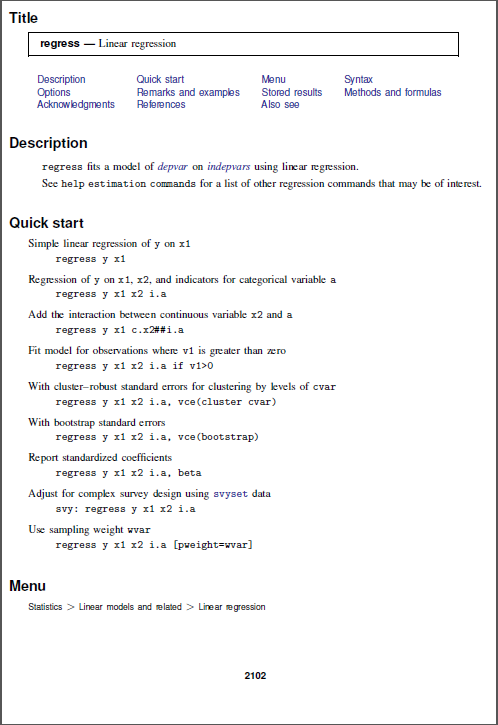Stata 15 documentation
|
Every installation of Stata includes all the documentation in PDF format. Stata’s documentation consists of over 14,000 pages detailing each feature in Stata including the methods and formulas and fully worked examples. You can transition seamlessly across entries using the links within each entry. In Stata 15, Quick starts help new users get started and remind experienced users of useful but less well-known options. |
Accessing
Access the PDF documentation from the Help menu within Stata.

See the recommended viewer settings for viewing the PDF manuals.
You can also access the PDF entry from Stata’s help files. Each help file has a Title with the manual shortcut and entry name in blue. Click on the blue link in the Title.
Table of contents
Each manual has its own table of contents. A combined subject table of contents contains the complete table of contents for all manuals and is divided into the following subjects:

- Getting started
- Data manipulation and management
- Utilities
- Graphics
- Statistics
- Matrix commands
- Programming
- Interface features
Click on a subject to go a the table of contents for that category.
Navigating
Across the top of each entry are links to each section within the entry. Clicking on Description, for example, will take you directly to the description of the feature.
 |
The bookmarks on the left-hand side also give you direct access to an entry, as well as each section within an entry. Click on the + next to the title to list the entries. Click on the + next to an entry to view the sections for that entry. |
Extended Regression Models
- Combine endodenous covariates, sample selection, and nonrandom treatment in models for continuous, interval-censored, binary, and ordinal outcomes
Finite Mixture Models
- fmm prefix for 17 estimators
- Mixtures of a single estimator
- Mixtures combining multiple estimators or distributions
- Continuous, binary, count, ordinal, categorical, censored, truncated, and survival outcomes
Linearized Dynamic Stochastic General Equilibrium
- Specify models algebraically
- Solve models
- Estimate parameters
- Identification diagnostics
- Policy and transition matrices
- IRFs
- Dynamic forecasts
Spatial Autoregressive Models
- Spatial lags of dependent variable, independent variables, and autoregressive errors
- Fixed and random effects in panel data
- Endogenous covariates
- Analyze spillover effects

